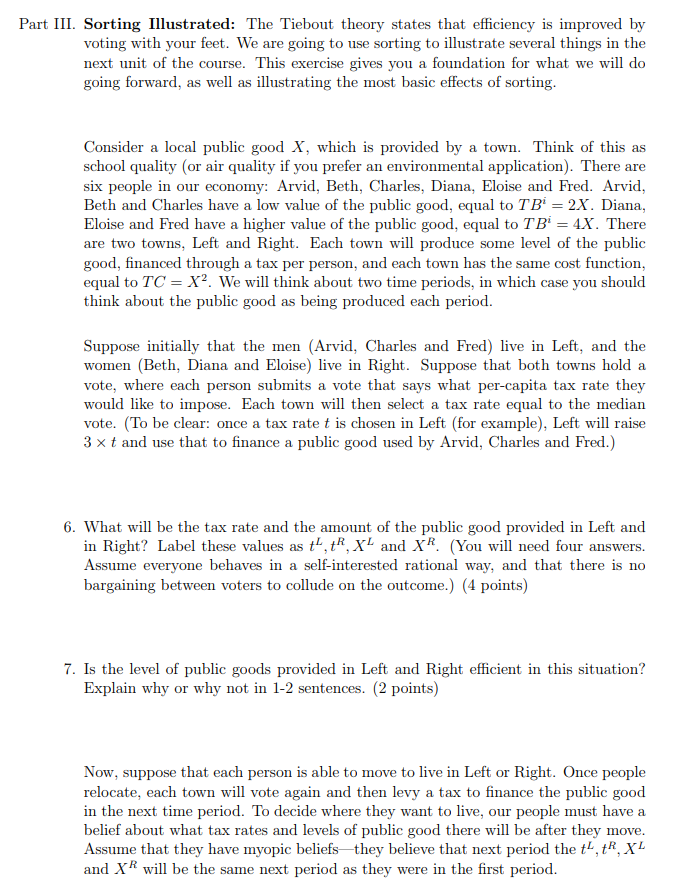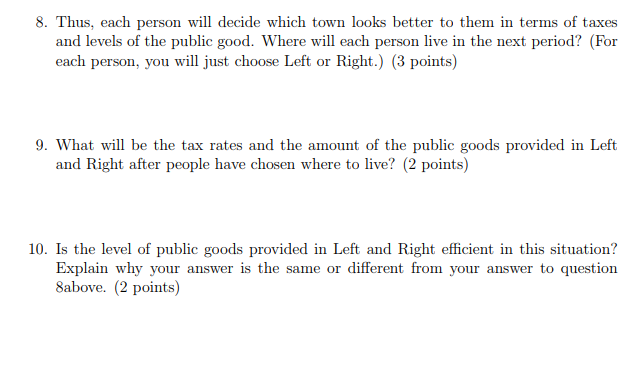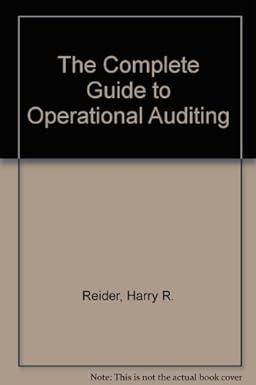

Part III. Sorting Illustrated: The Tiebout theory states that efficiency is improved by voting with your feet. We are going to use sorting to illustrate several things in the next unit of the course. This exercise gives you a foundation for what we will do going forward, as well as illustrating the most basic effects of sorting Consider a local public good X, which is provided by a town. Think of this as school quality (or air quality if you prefer an environmental application). There are six people in our economy: Arvid, Beth, Charles, Diana, Eloise and Fred. Arvid, Beth and Charles have a low value of the public good, eqal to TB 2X. Diana, Eloise and Fred have a higher value of the public good, equal to TB 4X. There are two towns, Left and Right. Each town will produce some level of the public good, financed through a tax per person, and each town has the same cost function equal to TC-X2. We will think about two time periods, in which case you should think about the public good as being produced each period. Suppose initially that the men (Arvid, Charles and Fred) live in Left, and the women (Beth, Diana and Eloise) live in Right. Suppose that both towns hold a vote, where each person submits a vote that says what per-capita tax rate they would like to impose vote. (To be clear: once a tax rate t is chosen in Left (for example), Left will raise 3 x t and use that to finance a public good used by Arvid, Charles and Fred.) Each town will then select a tax rate equal to the median 6. What will be the tax rate and the amount of the public good provided in Left and in Right? Label these values as t,tR, X and XR. (You need four answers. Assume everyone behaves in a self-interested rational way, and that there is no bargaining between voters to collude on the outcome) (4 points) 7. Is the level of public goods provided in Left and Right efficient in this situation? Explain why or why not in 1-2 sentences. (2 points) Now, suppose that each person is able to move to live in Left or Right. Once people relocate, each town will vote again and then levy a tax to finance the public good in the next time period. To decide where they want to live, our people must have a belief about what tax rates and levels of public good there will be after they move Assume that they have myopic beliefs they believe that next period the t,tR, XL and XR will be the same next period as they were in the first period Part III. Sorting Illustrated: The Tiebout theory states that efficiency is improved by voting with your feet. We are going to use sorting to illustrate several things in the next unit of the course. This exercise gives you a foundation for what we will do going forward, as well as illustrating the most basic effects of sorting Consider a local public good X, which is provided by a town. Think of this as school quality (or air quality if you prefer an environmental application). There are six people in our economy: Arvid, Beth, Charles, Diana, Eloise and Fred. Arvid, Beth and Charles have a low value of the public good, eqal to TB 2X. Diana, Eloise and Fred have a higher value of the public good, equal to TB 4X. There are two towns, Left and Right. Each town will produce some level of the public good, financed through a tax per person, and each town has the same cost function equal to TC-X2. We will think about two time periods, in which case you should think about the public good as being produced each period. Suppose initially that the men (Arvid, Charles and Fred) live in Left, and the women (Beth, Diana and Eloise) live in Right. Suppose that both towns hold a vote, where each person submits a vote that says what per-capita tax rate they would like to impose vote. (To be clear: once a tax rate t is chosen in Left (for example), Left will raise 3 x t and use that to finance a public good used by Arvid, Charles and Fred.) Each town will then select a tax rate equal to the median 6. What will be the tax rate and the amount of the public good provided in Left and in Right? Label these values as t,tR, X and XR. (You need four answers. Assume everyone behaves in a self-interested rational way, and that there is no bargaining between voters to collude on the outcome) (4 points) 7. Is the level of public goods provided in Left and Right efficient in this situation? Explain why or why not in 1-2 sentences. (2 points) Now, suppose that each person is able to move to live in Left or Right. Once people relocate, each town will vote again and then levy a tax to finance the public good in the next time period. To decide where they want to live, our people must have a belief about what tax rates and levels of public good there will be after they move Assume that they have myopic beliefs they believe that next period the t,tR, XL and XR will be the same next period as they were in the first period








